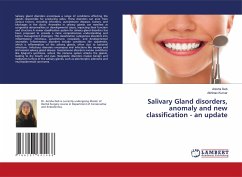
Salivary Gland Disorders
Versandkostenfrei!
Versandfertig in 6-10 Tagen
45,99 €
inkl. MwSt.

PAYBACK Punkte
23 °P sammeln!
This book describes that the oral cavity is a moist environment; a film of fluid called saliva constantly coats its inner surfaces and occupies the space between the lining oral mucosa and the teeth. Salivary function provides host protection, assists in the initiation of food and fluid intake, and enables communication through speech. Without adequate salivary output, oral and pharyngeal health declines along with a person's quality of life. Salivary dysfunction, however, is not a normal consequence of growing older, and is due to systemic diseases, medications, and head and neck radiotherapy...
This book describes that the oral cavity is a moist environment; a film of fluid called saliva constantly coats its inner surfaces and occupies the space between the lining oral mucosa and the teeth. Salivary function provides host protection, assists in the initiation of food and fluid intake, and enables communication through speech. Without adequate salivary output, oral and pharyngeal health declines along with a person's quality of life. Salivary dysfunction, however, is not a normal consequence of growing older, and is due to systemic diseases, medications, and head and neck radiotherapy. While complains of xerostomia may be indicative of salivary gland disorder, salivary diseases can present without symptoms. Therefore, routine examination of salivary function must be part of any head, neck and oral examination. Health care professionals can play a vital role in identifying patients at risk for developing salivary dysfunction and should provide appropriate preventive and interceptive techniques that will help preserve a person's health, function, and quality of life.












